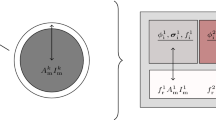Abstract
In modelling the electrical behaviour of muscle tissue, we used to employ a frequency-dependent volume conductor network model, which was infinitely extended in all directions. Equations in this model could be solved using a finite-difference approach. The most important restriction of this model was the fact that no boundary effects could be incorporated. Analytical models of muscle tissue normally do not have this disadvantage, but in those models the microscopic structure of muscle tissue cannot be taken into account. In the paper, we present a combined numerical/analytical approach, which enables the study of potential distributions and SFAPs in simulated microscopic muscle tissue in which the influence of the muscle boundary has been considered. We considered muscle models with radii of 1·5 mm and 10mm. Both models were compared with an unbounded network model. In the model with a radius of 1·5mm we varied the position of the active fibre relative to the muscle surface. It appeared that in most cases the presence of a boundary had a considerable effect on the potential distribution. An increase in the peak-to-peak value of the SFAP amplitude up to 300 per cent was noticed when the active fibre was positioned 500 μm beneath the muscle surface in a model with a radius of 1·5mm.
Similar content being viewed by others
References
Albers, B. A., Rutten, W. L. C., Wallinga-de Jonge, W. andBoom, H. B. K. (1986) A model study on the influence of structure and membrane capacitance on volume conduction in skeletal muscle tissue.IEEE Trans.,BME-33, 681–689.
Albers, B. A., Rutten, W. L. C., Wallinga-de Jonge, W. andBoom, H. B. K. (1988a) Microscopic and macroscopic volume conduction in skeletal muscle tissue, applied to simulation of single-fibre action potentials.Med. & Biol. Eng. & Comput.,26, 605–610.
Albers, B. A., Rutten, W. L. C., Wallinga-de Jonge, W. andBoom, H. B. K. (1988b) Sensitivity of the amplitude of the single muscle fibre action potential to microscopic volume conduction parameters.,26, 611–616.
Albers, B. A., Put, J. H. M., Wallinga, W. andWirtz, P. (1989) Quantitative analysis of single muscle fibre action potentials recorded at known distances.Electroenceph. & Clin. Neurophysiol.,73, 245–253.
Clark, J. andPlonsey, R. (1968) The extracellular potential field of the single active nerve fiber in a volume conductor.Biophys. J.,8, 842–863.
de Weerd, J. P. C. (1984) Volume conduction and electromyography. InCurrent practice of clinical myography.Notermans, S. L. H. (Ed.), Elsevier, Amsterdam, 9–28.
Epstein, B. R. andFoster, K. R. (1983) Anisotropy in the dielectric properties of skeletal muscle.Med. & Biol. Eng. & Comput.,21, 51–55.
Gath, I. andStålberg, E. (1979) Measurements of the uptake area of small size electromyographic electrodes.IEEE Trans.,BME-26, 374–376.
Gielen, F. L. H., Cruts, H. E. P., Albers, B. A., Boon, K. L., Wallinga-de Jonge, W. andBoom, H. B. K. (1986) Model of electrical conductivity of skeletal muscle based on tissue structure.Med. & Biol. Eng. & Comput.,24, 34–40.
Gootzen, T. H. J. M. (1990) Muscle fibre and motor unit action potentials. Ph.D. thesis, University of Nijmegen, The Netherlands.
Lichtenberg, B. K. andDeLuca, C. J. (1979) Distinguishability of functionally distinct evoked neuroelectric signals on the surface of a nerve.IEEE Trans.,BME-26, 228–237.
Meier, J. H., Rutten, W. L. C. andPut, J. H. M. (1990) Modelling and testing of multipolar intraneural stimulation. Proc. 12th Ann. Conf. of the IEEE EMBS, Philadelphia, Pennsylvania, 1st–4th Nov., 2240–2241.
Nandedkar, S. D. andStålberg, E. (1983) Simulation of single muscle fibre action potentials.Med. & Biol. Eng. & Comput.,21, 158–165.
Plonsey, R. (1969)Bioelectric phenomena. McGraw-Hill, New York.
Plonsey, R. (1974) The active fiber in a volume conductor.IEEE Trans.,BME-21, 371–381.
Rosenfalck, P. (1969) Intra-and extracellular potential fields of active nerve and muscle fibres. InA physicomathematical analysis of different models. Akademisk Forlag, Copenhagen.
Roth, B. J., Gielen, F. L. H. andWikswo, J. P. (1988) Spatial and temporal frequency-dependent conductivities in volume-conduction calculations for skeletal muscle.Math. Biosci.,88, 159–189.
Roth, B. J. (1989) Interpretation of skeletal muscle four-electrode impedance measurements using spatial and temporal frequency-dependent conductivities.Med. & Biol. Eng. & Comput.,27, 491–495.
Trayanova, N. A., Henriquez, C. S. andPlonsey, R. (1990) Limitations of approximate solutions for computing the extracellular potential of single fibers and bundle equivalents.IEEE Trans.,BME-37, 22–35.
Trayanova, N. A. (1990) Electrical behaviour of a skeletal muscle fiber in a volume conductor of finite extent.Biol. Cybern.,63, 121–125.
van Veen, B. K., Rutten, W. L. C. andWallinga, W. (1990) Influence of a frequency-dependent medium around a network model, used for the simulation of single-fibre action potentials.Med. & Biol. Eng. & Comput.,28, 492–497.
Wallinga-de Jonge, W., Gielen, F. L. H., Wirtz, P., de Jong, P. andBroenink, J. (1985) The different intracellular action potentials of fast and slow muscle fibres.Electroencephal. & Clin. Neurophysiol.,60, 539–547.
Wallinga, W., Albers, B. A., Put, J. H. M., Rutten, W. L. C. andWirtz, P. (1988) Activity of single muscle fibres recorded at known distances. InElectrophysiological kinesiology.Wallinga, W., Boom, H. B. K., andde Vries, J. (Eds.), Elsevier Science Publishers BV, Amsterdam, 221–224.
Author information
Authors and Affiliations
Rights and permissions
About this article
Cite this article
van Veen, B.K., Rijkhoff, N.J.M., Rutten, W.L.C. et al. Potential distribution and single-fibre action potentials in a radially bounded muscle model. Med. Biol. Eng. Comput. 30, 303–310 (1992). https://doi.org/10.1007/BF02446968
Received:
Accepted:
Issue Date:
DOI: https://doi.org/10.1007/BF02446968




